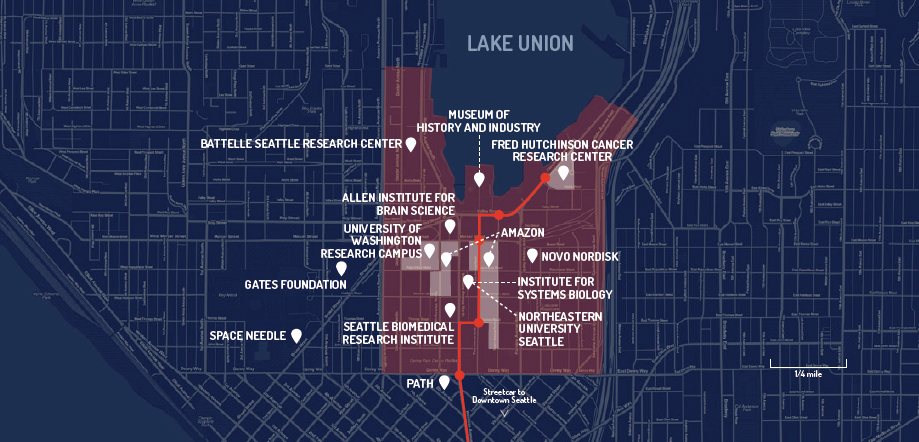Imagine a place where going to work means biking freely without the fear of cars to a coffee shop, where one collaborates with other people from nearby start-ups, research labs or universities. Sounds like a Portlandia episode? Truth is, a report released by the Brookings Institution’s Metropolitan Policy Program earlier this week states that such work environments are starting to emerge organically throughout the world – they’re called Innovation Districts.
These districts are defined as “geographic areas where anchor institutions and companies cluster and connect with small firms, startups, business incubators and accelerators.” Additionally, innovation districts are “physically compact, transit accessible, technically wired and offer a mix of housing, office and retail.”
Having a compact district where firms are near other firms, research labs and universities allows for “open innovation,” which is the sharing of ideas from “legal advice to sophisticated lab equipments.”
This environment, emerging particularly in the U.S. post Great Recession, is a far departure from the landscape of innovation that has dominated the past 50 years – suburban corridors of isolated corporate campuses, accessible mainly by car with little to no attention to integrating work, housing and recreation.
Here are six cities in the U.S. from East Coast to West Coast with areas that fit Brookings’ definition of Innovation District (and to learn more about each, take a look at Brookings' visually compelling report here):
1. Boston: Innovation District
2. Philadelphia: University City
3. Raleigh–Durham: Research Triangle Park
4. Detroit: Downtown, Midtown
5. St. Louis: Cortex
6. Seattle: South Lake Union
Related Stories
| Nov 8, 2013
Oversized healthcare: How did we get here and how do we right-size?
Healthcare facilities, especially our nation's hospitals, have steadily become larger over the past couple of decades. The growth has occurred despite stabilization, and in some markets, a decline in inpatient utilization.
| Nov 8, 2013
Can Big Data help building owners slash op-ex budgets?
Real estate services giant Jones Lang LaSalle set out to answer these questions when it partnered with Pacific Controls to develop IntelliCommand, a 24/7 real-time remote monitoring and control service for its commercial real estate owner clients.
| Nov 8, 2013
S+T buildings embrace 'no excuses' approach to green labs
Some science-design experts once believed high levels of sustainability would be possible only for low-intensity labs in temperate zones. But recent projects prove otherwise.
| Nov 8, 2013
Net-zero bellwether demonstrates extreme green, multifamily style
The 10-unit zHome in Issaquah Highlands, Wash., is the nation’s first net-zero multifamily project, as certified this year by the International Living Future Institute.
| Nov 8, 2013
Walkable solar pavement debuts at George Washington University
George Washington University worked with supplier Onyx Solar to design and install 100 sf of walkable solar pavement at its Virginia Science and Technology Campus in Ashburn, Va.
| Nov 6, 2013
PECI tests New Buildings Institute’s plug load energy use metrics at HQ
Earlier this year, PECI used the NBI metrics to assess plug load energy use at PECI headquarters in downtown Portland, Ore. The study, which informed an energy-saving campaign, resulted in an 18 percent kWh reduction of PECI’s plug load.
| Nov 5, 2013
Net-zero movement gaining traction in U.S. schools market
As more net-zero energy schools come online, school officials are asking: Is NZE a more logical approach for school districts than holistic green buildings?
| Nov 5, 2013
New IECC provision tightens historic building exemption
The International Energy Conservation Code has been revised to eliminate what has been seen as a blanket exemption for historic buildings.
| Nov 5, 2013
Living Building Challenge clarifies net-zero definitions and standards
The Living Building Challenge has released the Net Zero Energy Building Certification to provide clearer definitions regarding what net zero really means and how it is to be achieved.
| Nov 5, 2013
Oakland University’s Human Health Building first LEED Platinum university building in Michigan [slideshow]
Built on the former site of a parking lot and an untended natural wetland, the 160,260-sf, five-story, terra cotta-clad building features some of the industry’s most innovative, energy-efficient building systems and advanced sustainable design features.























